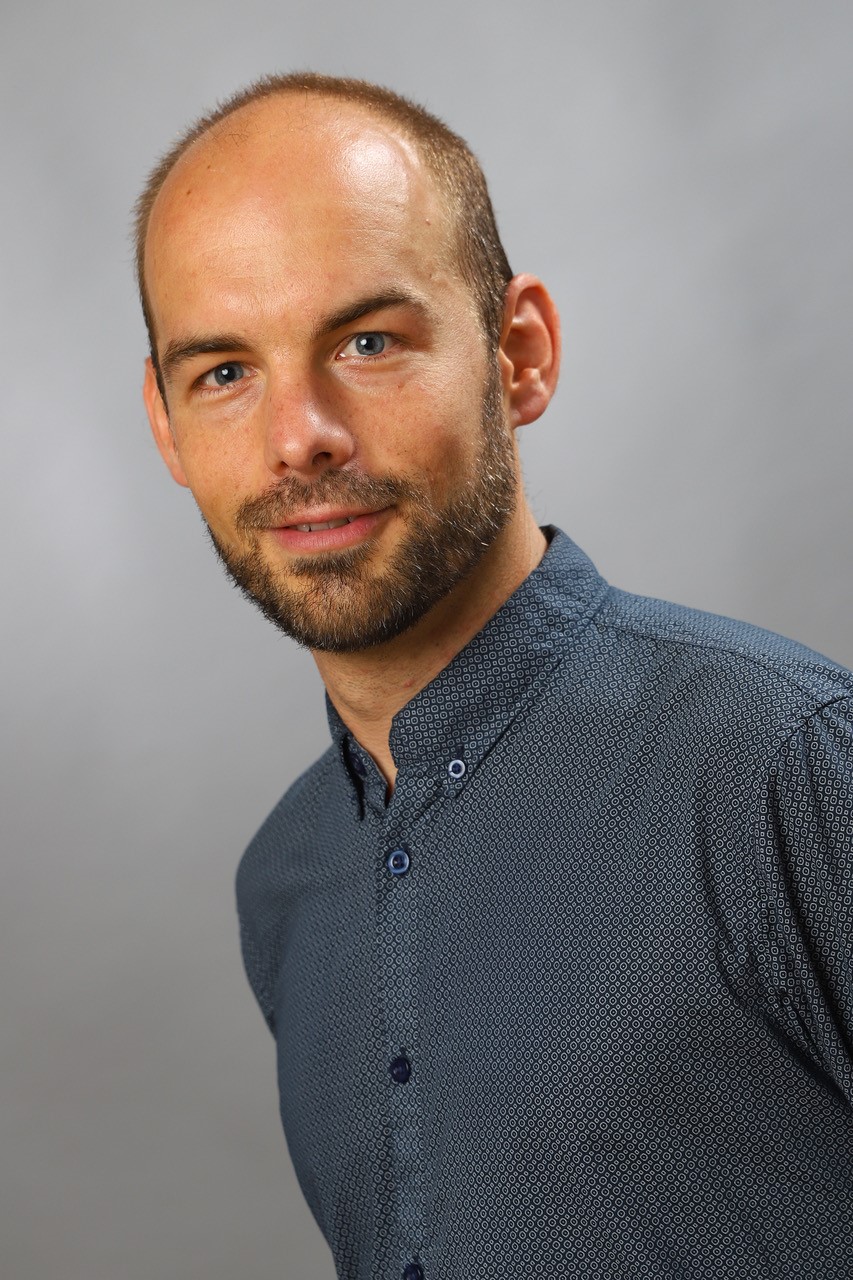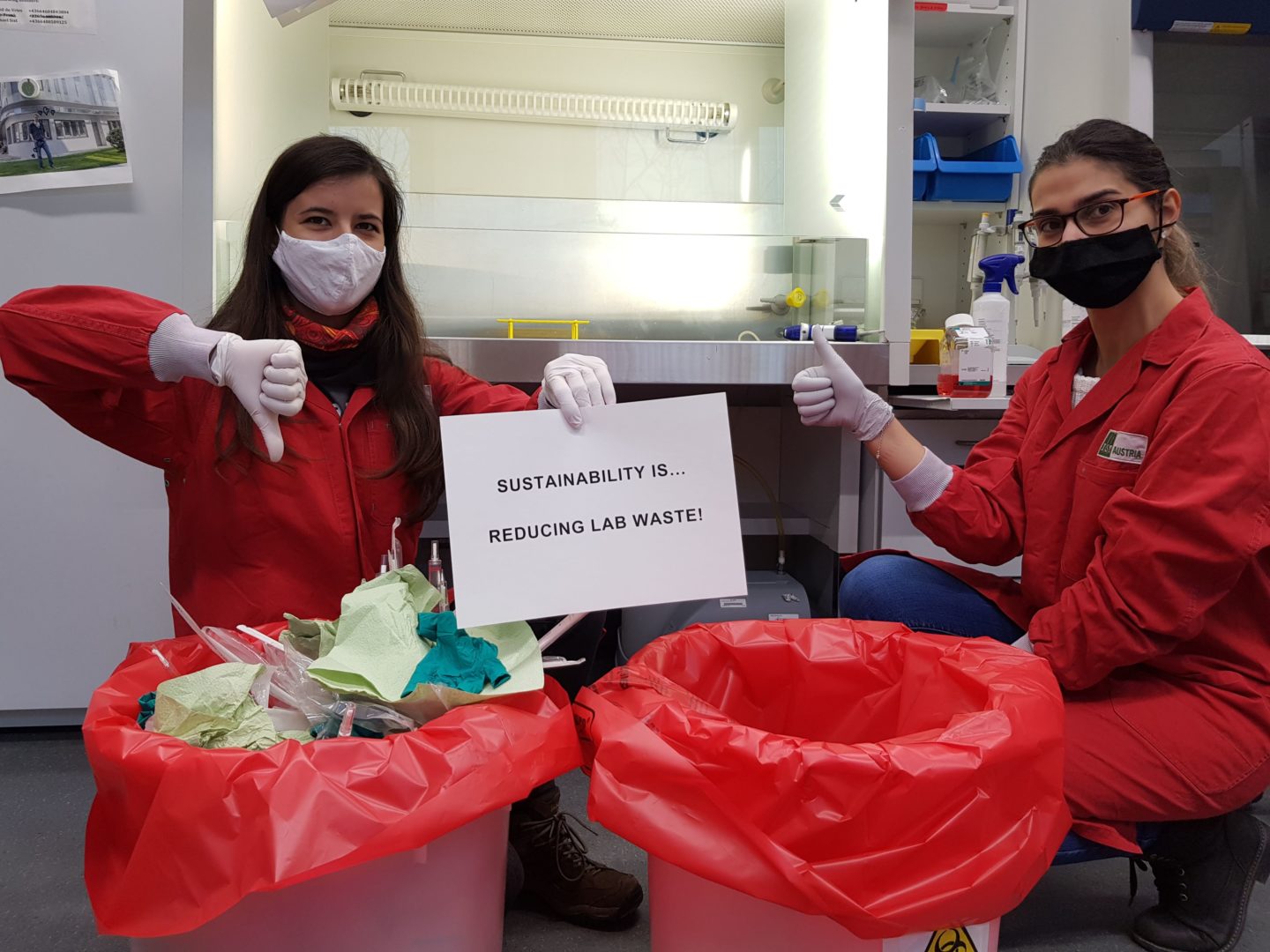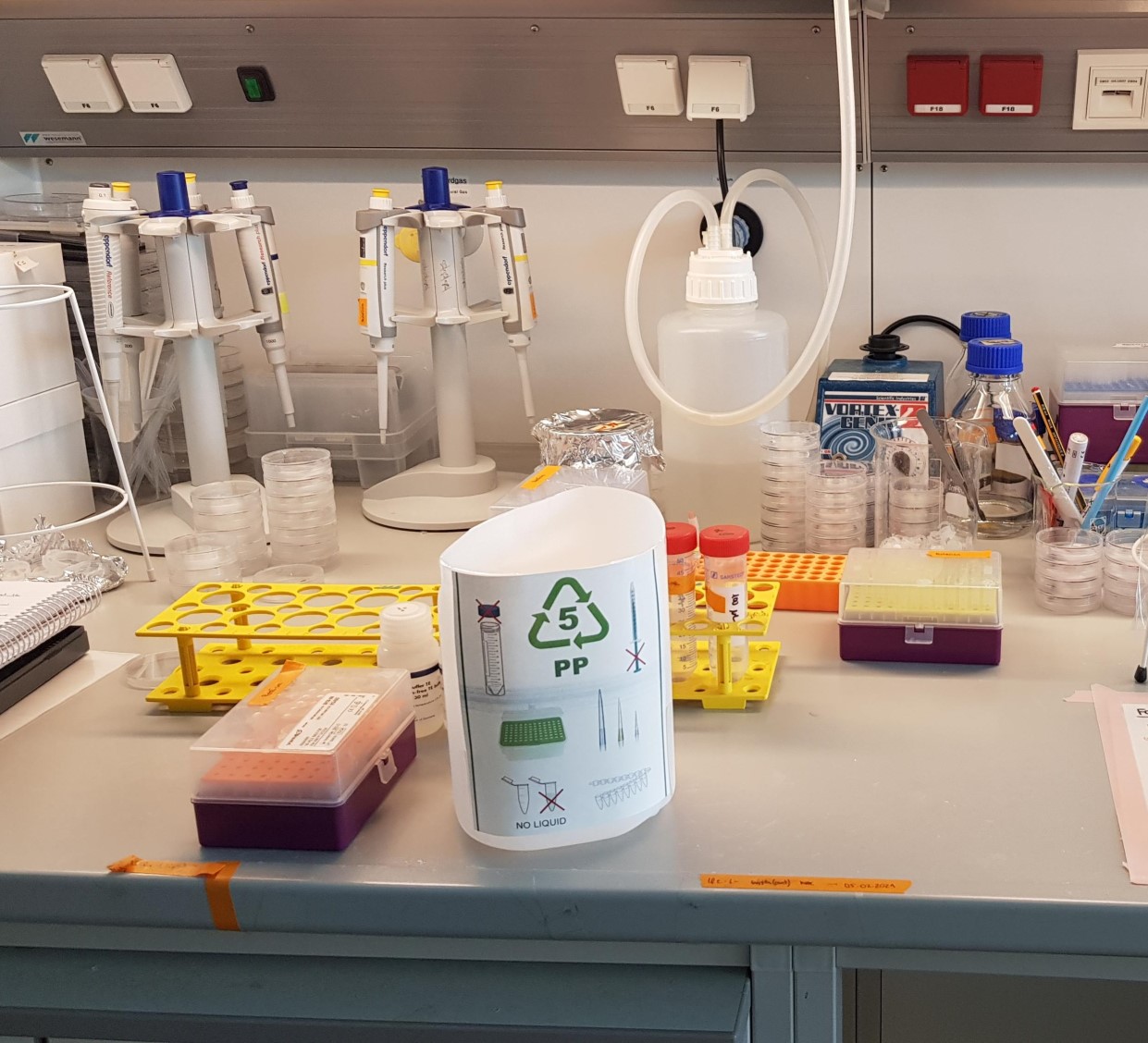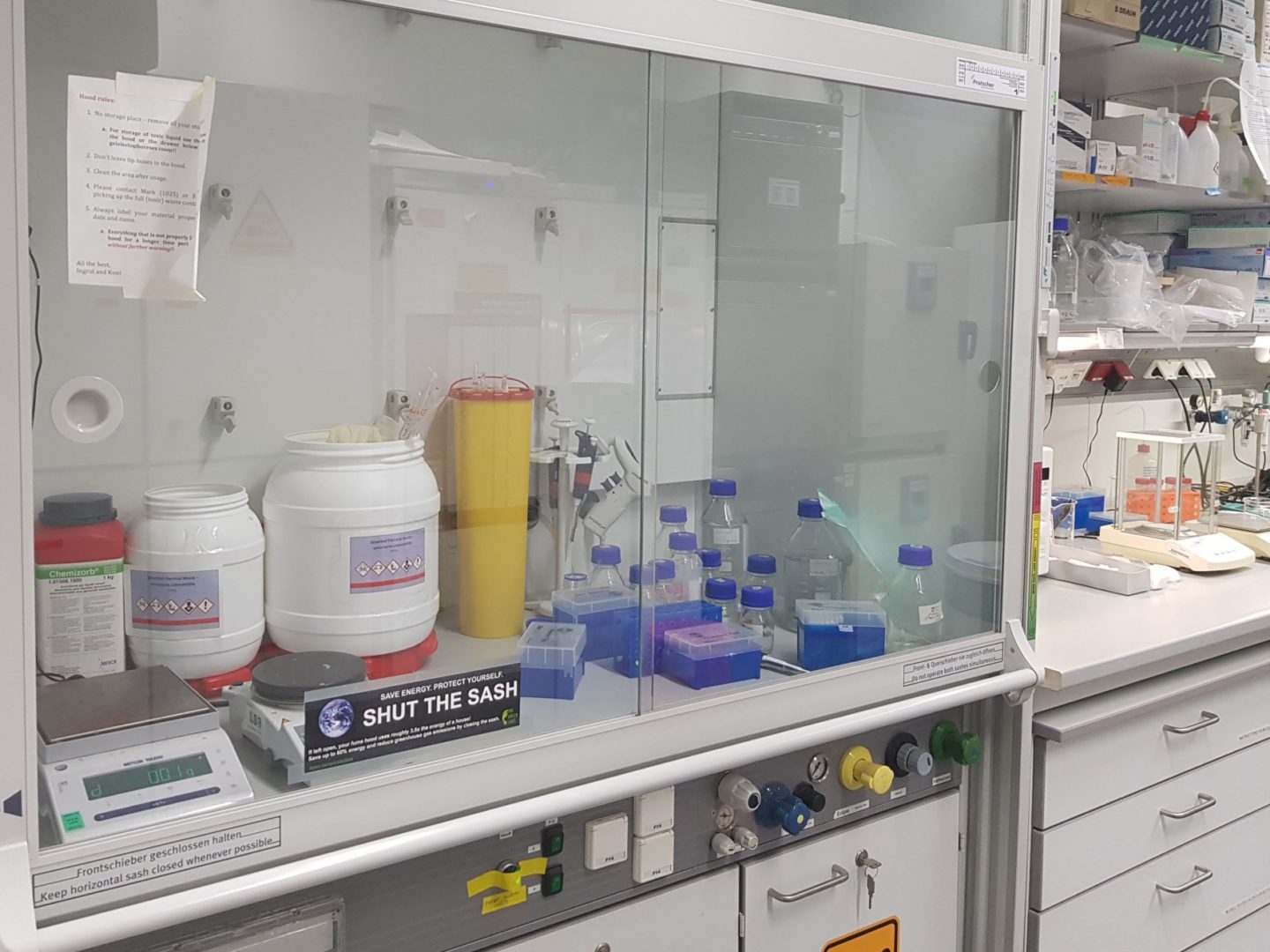May 20, 2021
Polluting Labs: Researchers for new Solutions
As part of an Austria-wide initiative, researchers at IST Austria are campaigning for more environmentally friendly laboratories.
To get correct results, researchers have to work cleanly. However, in doing so they sometimes produce a lot of waste: at the end of a working day in the lab, the dustbins overflow with disposable gloves, plastic pipettes and petri dishes. The next generation of top researchers at IST Austria wants to change that and has joined an Austria-wide initiative to make laboratories more environmentally friendly.
Paul Schanda doesn’t have a car. Whenever possible he rides his bike, and tries to avoid air travel. Nevertheless, his ecological footprint is probably significantly larger than that of an average Austrian. “I’m convinced that the main problem in terms of ecological impact is my work life and not my private life,” Schanda says. That is because he is an experimental scientist – in September, the biochemist will open his own research group at the Institute of Science and Technology (IST) Austria studying how proteins interact and how their dynamics are related to their functions. “I would like to at least consider from the beginning on how to make it as little polluting as possible,” says the IST Austria professor.

Science, especially experimental science, has a pollution problem. This becomes particularly clear when looking into the laboratory rubbish bin at the end of the day, where bottles, flasks, pipettes, syringes and disposable gloves made of a wide variety of plastics are piling up. “As a cell biologist, everything I work with has to be sterile, and disposable plastic is best for this because you can be sure that the samples will not be contaminated,” describes Nikola Čanigová, PhD student at IST Austria. Her research focuses, among other things, on how immune cells invade and travel in complex environments like different tissues. “But the amount of waste I was producing was horrendous – I was very appalled.”
Going green
The Green Labs Austria initiative has calculated how big the problem really is. According to them, a single microbiology lab consumes about as much plastic as 13 Austrian households combined. That is about 1.3 tons of plastic waste per year. The goal of the initiative is to raise awareness among researchers about the problem and connect research groups so they can help each other find better solutions to environmentally harmful practices. Currently, laboratories at the University of Vienna, the Medical University Graz, the Johannes Kepler University Linz and, since recently, two groups at IST Austria are part of the network: The Barton and Sixt group, the group Nikola Čanigová belongs to, want to become “greener”.

“I didn’t want to do science in such a polluting way – that motivated me to do something about it,” describes the Slovakian-born scientist. Austria’s neighbor is one of the countries in the European Union that invests the least money in research: in 2019, it was only 0.83 percent of the gross domestic product. By comparison, Austria invested around 3.19 percent in the same period. “In Slovakia, laboratories have to be more sustainable with their resources, they have no choice. At institutes like IST Austria, we can do research very efficiently, but that can make people think less about plastic waste.” Together with lab technicians and other students, she therefore wants to create more awareness of how research can be done in a more resource-conserving and environmentally friendly way.
Reduce, Reuse, Recycle
The mantra here is: Reduce, Reuse, Recycle. “We try to eliminate plastic wherever possible. Instead of pipetting, sometimes liquids can be poured if you don’t have to be very precise,” which saves on disposable pipettes, Čanigová says. The point is to think about every plastic product to see if it is really necessary to use it or if there is an environmentally friendly alternative such as reusable glass ware. These are provided, washed and sterilized at IST Austria by the so-called Media and Cleaning Kitchen. Depending on what they contained before, some plastics could also be washed out and reused directly at the laboratory.

Finally, indispensable single-use plastic products should be recycled. However, that is easier said than done. “Right now, there are only two types of plastic that we can recycle with the help of the organization Helfen statt Wegwerfen: polyethylene and polypropylene,” the biologist explains. They are used, for example, to make parts for syringes, pipettes, cell culture flasks and falcon tubes. To make it as easy as possible to separate plastics, Čanigová and her colleagues have started to place small trashcans at the end of each workbench in their lab. Pictures show what can be disposed of in them. When the trashcans are full, the committed scientists take the material to a larger dumpster in the neighboring building. The plastic waste is stored there until enough material has been collected so that it can be picked up free of charge by the Austrian non-profit organization and recycled.
Shut the sash
Another, less obvious, but all the more serious environmental problem in science is its high energy consumption. In their research, Paul Schanda and Nikola Čanigová work with a variety of biological samples that have to be stored at very low temperatures. For this purpose, freezers are available that are set to minus 80 degrees Celsius, consuming as much energy as two Austrian households. If the temperature was raised by just ten degrees, 31 percent of the energy consumption could be saved. But what would that mean for the sensitive biological material? The Green Labs Austria initiative looked into various studies and finally raised the temperature of their freezer at the University of Vienna, it turned out: For soil as well as DNA samples up to enzymes, the change made no difference.

Nikola Čanigová also knows from her own experience how important it is to be aware of the problem and to know about the sometimes simple solutions. Under special fume hoods, researchers can handle substances that emit hazardous vapors. The energy consumption of one of these hoods is equivalent to that of eight households. But with a simple trick, it can be reduced by 60 percent: “Shut the Sash” is written in capital letters on the hood in Čanigová’s lab. The stickers remind the scientists to close the lid. Other devices that are used by many different people have been connected to time switches that automatically turn the device off after a certain amount of time. This way, they prevent the devices on the shared workspace from unnecessarily running overnight or on weekends.
It’s not about saving the planet
“Since we started discussing the issue, things have really changed in my lab, and people are coming up with new ideas what we can change,” Čanigová says enthusiastically. In general, she says, other research groups on campus seem to be very interested in the topic as well, but many technical details, such as how to recycle different types of plastic, still need to be worked out. In the future, the scientist hopes that special attention will be paid to the environmental compatibility of laboratory materials when they are ordered, and that the issue will be given greater priority. At present, the group of environmentally conscious scientists and technicians are committed to the project in addition to their demanding work in cutting-edge research. “Some people think it’s about saving the planet, but it’s not,” says Paul Schanda. “The planet will be fine even if we create circumstances that temporarily wipe out our species. We ourselves have the problem.” There already are good ideas within the scientific community, he says, but they are often not implemented on a larger scale if this means additional costs. However, in an economic system that does not recognize the limits of the planet and considers natural resources to be infinite and for free, economic arguments do not get us anywhere. “We have a responsibility to care. It is in our own interest and that of the next generation,” Schanda is convinced.

Further information:
https://at.scientists4future.org
Gaia Bistulfi (2013): Reduce, reuse and recycle lab waste. Nature. https://doi.org/10.1038/502170a



